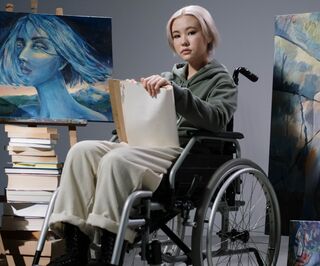Bias
Disabled, Asian American, and Proud
Some Asian Americans are building disability pride in the face of stigma.
Posted July 27, 2022 Reviewed by Ekua Hagan
Key points
- Nearly 1.3 million Asian Americans identify as having a disability.
- Disability remains heavily stigmatized in the Asian American community, leading to a lack of support.
- Disabled Asian Americans may be simultaneous targets of both ableism and racism.
- Asian American organizations and activists are changing the narrative through disability pride.

By Sydney Tran and Kathleen Bogart
July marks Disability Pride Month, which celebrates the anniversary of the passing of the Americans with Disability Act (ADA). The ADA is a landmark civil rights law preventing discrimination against people with disabilities in all areas of public life, including at work, in school, and on transportation.
During Disability Pride Month, the disability community gathers in celebration of their disability identity, communities participate in parades, and organizations may highlight progress made in improving accessibility. Many things play a role in shaping one’s path to experiencing disability pride, with one important factor being one’s racial or ethnic group’s views on disability.
Asian Americans and disability
Nearly 1.3 million Asian Americans identify as having a disability. Despite 1 in 10 Asian Americans having a disability, disability remains heavily stigmatized among the Asian American community. When compared to African Americans, European Americans, and Latinos, Asian Americans report the highest rates of stigma toward physical and mental disabilities.
This can be attributed to the concept of saving face. In Asian culture, face is defined as one’s respectability, prestige, and positive social value, as ascribed by others. There are several ways in which one may lose face, such as being in an undesirable predicament or failing to meet others’ expectations. In attempts to save face, or maintain their respectability, prestige, and positive social value, the disabled person or their family may hide the disability, further perpetuating stigma.
Chinese and Southeast Asian families have described disability as a form of karma or a curse for previous wrongdoing, beliefs that are rooted in the moral model of disability. Under this model, it is believed that disability is the result of karma or a sign of the person’s or their family’s moral weakness. The disabled person or their family is thought to be morally responsible for their disability. Within some Asian cultures, the birth of a child with a disability is believed to signify the family’s wrongdoing. Out of fear of losing face, parents may opt to remain private about their child’s disability, refrain from seeking a diagnosis, hide the child away, and/or refuse medical and social services or support.
While some of these hesitancies are rooted in cultural beliefs, there certainly exist structural barriers that perpetuate the silencing of disability among the Asian American community. For example, when various social services were surveyed about their experiences in working with Asian American clients, lack of translators and lack of cultural sensitivity were among some of the major barriers to utilizing services for family members with disabilities. In another study, Asian American parents reported frustrations around the complexity of handouts and readings provided by medical professionals because they made it difficult to fully understand their child’s diagnosis. Additionally, disabled Asian Americans face a unique set of challenges because they may be simultaneous targets of both ableism and racism.
Out of fear of bringing attention to the stigma, a person with a disability or their family may avoid associating with other disabled people. Lack of support from both non-disabled and disabled people, as well as silencing of one’s disability, may lead the disabled child to internalize the shame and prevent them from developing a positive disability identity and feeling a sense of pride in their disability. Alternatively, as the disabled child matures, they may begin exploring alternative views of disability, connecting with other disability community members, and advocating for themself and their needs. In turn, they may form more positive views on disability and grow to feel empowered in their disability identity.
Resources and recommendations
There are several recommendations for local communities and policymakers to de-stigmatize disability among the Asian American community and improve social services.
- Provide resources for Asian Americans on how to have conversations about disability with their families and in their community.
- Train healthcare and social service workers to be culturally sensitive when interacting with disabled Asian Americans.
- Make handouts and readings accessible by using layperson language and offering pamphlets in the person’s desired language.
- Conduct more research on the unique struggles of disabled Asian Americans as a product of both disability and Asian American identities.
A growing number of resources are being created by disabled Asian Americans for disabled Asian Americans, including the Asian Americans with Disabilities Initiative (AADI), Asians and Pacific Islanders with Disabilities of California (APIDC), and Asian Center Southeast Michigan (AC-SE MI).
AADI created a resource guide to combat ableism in the Asian American disability community and racism in the disability community. The guide includes peer-reviewed research studies, tips on improving digital and physical accessibility, ways to be an anti-racist ally to the disability community, and interactive writing prompts to reflect on one’s disabled Asian American identity.
APIDC provides resources for improving accessibility to campus mental health services and organizes conferences for disabled API to connect and share research. APIDC also provides opportunities for the next generation of disabled API activists to develop skills in grassroots organizing and leadership through their Youth Leadership Institute.
AC-SE MI provides educational resources on chronic illnesses that disproportionately impact the Asian American community, including diabetes and Hepatitis B. They also offer programs for conducting Hepatitis B screening and delivering Hepatitis B vaccines, hold biennial health expos to provide culturally-relevant health education services, and train caregivers of family members with dementia.
In addition to these organizations, a number of disabled Asian American activists are leading the fight in combatting ableism and racism in their communities:
- Alice Wong is a disability rights activist and is the founder and director of the Disability Visibility Project (DVP). DVP is an online community dedicated to creating and highlighting disability media and culture. Alice also serves as a co-partner on various projects, including (1) DisabledWriters.com, a resource designed to increase disability diversity in journalism, (2) #CripTheVote, an online movement to encourage individual and collective political action, and (3) Access Is Love, an initiative to raise awareness about and improve accessibility for all.
- Chella Man is an artist who identifies as a Jewish and Chinese Deaf, genderqueer, transgender man. He has created art that captures experiences at the intersections of disability, race, gender, and sexuality, published a book on his journey of healing from systemic oppression, and has traveled across the country to give talks about his work.
- Mia Ives Rublee is the director of the Disability Justice Initiative at The Center for American Progress. She partners with business and nonprofit organizations across the United States, advocating for disability justice and inclusion. She founded the Women’s March Disability Caucus, worked as an organizer for previous political campaigns, and was recently appointed to the President’s Advisory Commission on Asian Americans, Native Hawaiians and Pacific Islanders.
Together, the work by organizations like AADI, APIDC, AC-SE MI, and activists like Wong, Man, and Ives-Rublee are leading the way for de-stigmatizing disability among the Asian American community and beyond. They redefine what it means to have a disability, transforming ideas about disability being a source of shame or weakness to disability being a source of pride and empowerment.
Sydney Tran, M.S., is a Ph.D. candidate in Kathleen Bogart’s Disability and Social Interaction Lab at Oregon State University.




